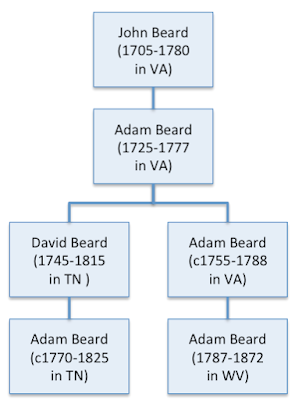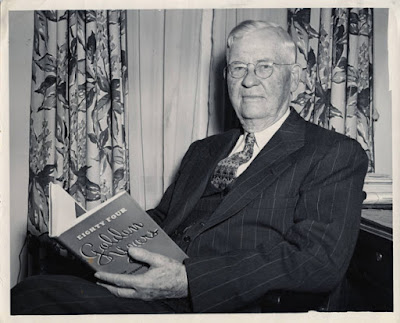After researching the ancestors of my great grandmother, Effie (Beard) Jennings (1871-1906), I learned she was the daughter of David Fleming Beard, Sr., and his second wife, Barbara Ann Mitchell. Barbara Ann was great granddaughter of Robert "the Elder" Mitchell (1714-1799).[1] Robert Mitchell was born in Londonderry and immigrated with his parents and siblings to Pennsylvania. They settled in Pequea, Pennsylvania, where many Presbyterians of Scottish descent settled prior to the Revolutionary War. We known Robert "the Elder" Mitchell migrated to Bedford County, Virginia, where he wrote his will and died in 1799.
Many, many family trees indicate Robert is the son of John Mitchell and Mary Boyd. I do not believe these are the correct parents for Robert "the Elder" Mitchell. Instead I believe his parents were Robert Mitchell and Mary Innes said to be of Edinburgh, Scotland, for the following reasons:
John Mitchell's Will
John Mitchell was born on 1 July 1682 in Londonderry and he wrote his will on 14 February 1771 in Augusta County, Virginia. (
Chronicles of Scotch-Irish Settlement in Virginia: Extracted from the Original Court Records of Augusta County, 1745-1800 by Lyman Chalkely). This will has been cited as evidence that Robert (1714-1799) and James Mitchell (between 1710-1720-before 1776) are John's sons.
In his will, he named Elizabeth, his wife (not Mary Boyd) and the following children: Thomas, Robert, John, James, Elenor (Mitchell) Wilson, Mary (Mitchell) Right, and Elizabeth. Son James was born about 1742 in Augusta County and could not be the James Mitchell who married Margaret Caldwell circa 1751. All of John Mitchell's other known children who were alive at the time of his death were mentioned in his will.
Several sons with given names whose descendants are DNA matches were not mentioned in the will.
Robert Mitchell's Will
Robert "the Elder" Mitchell wrote his will on 23 April 1781; it was proved on 25 February 1799 in Bedford County, Virginia. The will includes the following bequests:
"To my beloved wife Mary I give the Plantation I now live on during her life or widowhood, at the end of either I give it to my son Samuel. Also to my wife Mary I give all my movable Estate to be disposed of at her discretion...
To my son Daniel I give one hundred acres of Land where he now lives.
To Robert and Stephen I Give the remainder of the Upper Tract I bought off Hilton.
To Josiah Campbell the lower half of the same tract."
Rev. William Henry Foote wrote of Rev. James Mitchell, son of Robert "the Elder" Mitchell, in his book,
Historical and Biographical Sketches of Virginia, based on information he received from a Mitchell descendant, Rev. Jacob D. Mitchell in 1854:
"...He father Robert Mitchel, was born in the north of Ireland but emigrated to America while still a youth...His wife, whose maiden name was Mary Enos, was, it seems of Welsh extraction...This excellent pair resided in Bedford County for many years...They had 13 children, of whom not one died less than 70 years."
Only five children are named in his will, and I have 15 possible children in my tree. I have been using DNA to confirm which of those 15 children belong to Robert Mitchell and Mary Enos. Using DNA and documentary evidence I have been able to prove these children: Susannah Mitchell, who married Josiah Campbell; Rev. James Mitchell; Stephen Mitchell; Robert Harvey Mitchell; Mary Mitchell, who married Samuel Beard; Margaret Mitchell, who married Adam Beard; Martha Ann Mitchell, who married Samuel Claytor; and Daniel Mitchell.
Mary Innes/Mary Enos Problem
Several trees have compressed two generations of Robert Mitchells into one generation. I believe the problem was caused by the similarities of their wives' maiden names.
Robert "the Immigrant" Mitchell, married to Mary Innes, immigrated to Pennsylvania when with his wife and young children in about 1735. One of his sons, also named Robert, who I call "the Elder," married to Mary Enos in Delaware.
Other children of Robert "the Immigrant" may be Daniel (about 1718-1775), married to Mary Caldwell, and James (before 1720-before 1776), married to Margaret Amey Caldwell.
Daniel Mitchell's Will
Daniel Mitchell was born about 1718 in Londonderry and wrote his will on 13 June 1775 in Bedford County. An estate inventory and appraisal was filed with the court on 18 October 1775 so I am assuming he died between June and October 1775. In his will he named his brother Robert (including the relationship between them) as an executor. (
Abstracts of Bedford County, Virginia, Wills, Inventories, and Accounts, 1754-1787 by Joida Whitten)
Daniel made his brother his executor yet Daniel was not mentioned inJohn Mitchell's will which was written when he was still alive.
Geography
Documentary evidence of residence in Pennsylvania and Bedford County exists for Robert "the Elder" Mitchell. However, no documents proving residence in Augusta County have been discovered, which would be likely if Robert Mitchell was the son of James Mitchell and wife, Elizabeth. It is possible a Robert Mitchell lived in Augusta County but he has not been proved to be Robert "the Elder" Mitchell.
Books about the Mitchell Family
Shipley, Mitchell, and Thompson Families compiled by Stith Thompson and published in 1964 includes a family tree that indicated Daniel and Robert were brothers and their father was named Robert:
 |
| Mitchell family tree; image courtesy of Ancestry.com |
Mr. Thompson's book includes the following:
"Up to the present time we have few reliable records of this line of Mitchells before 1747. It is clear that at that time there were two brothers in Bedford County, Virginia, Daniel Mitchell and Robert Mitchell. What we know of the father of these brothers comes from letters embodying the traditions of the family of Rev. James Mitchell (son of Robert) who was born in 1747. These traditions assert that the father of Daniel and Robert was Robert Mitchell of Londonderry, Ireland. He is spoken of as "the Immigrant."
Mrs. W. H. Walthall of Roanoke, Virginia, wrote on 4 February 1895: Robert Mitchell was born in Londonderry, Ireland, in the latter part of the 17th century. His father's family suffered greatly in that noted siege of Londonderry (1689), of which he loved to talk. When a young man in the first part of the 18th century, he married Miss. Mary Innis of Edinburgh, Scotland, and moved to America and settled at Pequa, Pennsylvania.[2] They had thirteen children. While the children were young he moved to Virginia and settled in Bedford County. He raised them all and as soon as they became grown they scattered all over the Union, all married and raised large families. Rev. James Mitchell, my grandfather was his youngest child. He was born 29 January 1747."[3]
From a letter from Mrs. George P. Parker of Bedford, Virginia to Stith Thompson dated 24 September 1934 we have the following: "Robert and Daniel Mitchell were sons of Robert, Sr., the Immigrant. Daniel and Robert Mitchell, Scotch Irish immigrants landed at Philadelphia about 1735, went to Pequa and to Bedford County, Virginia, about 1754-56." (This information is from family notes belonging to Dr. John Mitchell of Bedford County.)
 |
| Pequea, Pennsylvania. The river is the Susquehanna; courtesy of RootsWeb |
Mr. Thompson believed the Mitchell brothers traveled to Lunenburg/Bedford County in a large party led by the Caldwell family.
DNA
My paternal uncle, siblings, cousins and I who descend from Effie (Beard) Jennings have 28 DNA matches that have a Mitchell as the common shared ancestor. For 26 of those matches Robert "the Immigrant" Mitchell was the common shared ancestor. This is not surprising as we descend from his son, Rev. James Mitchell (1747-1841). However, for two of those matches, the common shared ancestor was Robert "the Immigrant" Mitchell (before 1689-unknown). One descended through the son James Mitchell (between 1710-1720-before 1776) and the other descended through Daniel Mitchell (born about 1718-died 1775).
Conclusion
Based on family tradition, histories written just decades after the relevant people died, documentary evidence and DNA seem to support my conclusion that Robert "the Immigrant" Mitchell was the father of Robert "the Elder" Mitchell and at least two other sons -- Daniel and James. What is still unknown was which of the two Robert Mitchells had 13 children as one sources says the Immigrant and the other says the Elder. Perhaps one day we'll be able to solve that mystery.
_______________
[1] Effie (Beard) Jennings >> Barbara Ann (Mitchell) Beard >> Daniel Mitchell >> Rev. James Mitchell >> Robert "the Elder" Mitchell >> Robert "the Immigrant" Mitchell
[2] Bedford County was formed from Lunenburg County on 15 December 1753. Thereafter, the Robert Mitchell lived in Bedford County.
[3] Pequea (pronounced peck-way) was spelled Pequa in the Colonial Era.
[4] According to several documents I have found, Rev. James Mitchell was not the youngest son of Robert "the Elder" Mitchell and Mary Enos.
More information disputing the relationship between John Mitchell and Mary Boyd as the parents of Robert "the Elder" Mitchell may be found here: Mitchell Family History
Revisiting Daniel Mitchell, Patriot
Robert Mitchell, the Elder































